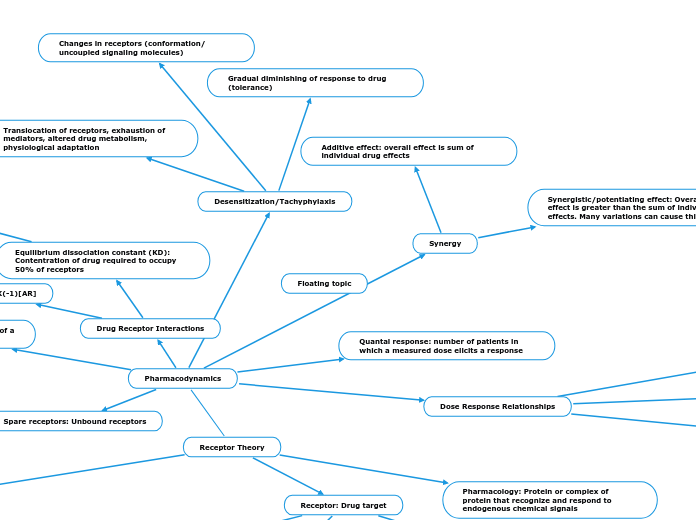Floating topic
Receptor Theory
Pharmacology: Protein or complex of protein that recognize and respond to endogenous chemical signals
Receptor: Drug target
Drug-receptor binding
Activation: Efficacy
Occupation:Affinity
Antagonist-->No response
Irreversible antagonist: Binds to receptor and remains there (usually covalent). Will reduce potency, but primarily affects efficacy
Allosteric antagonism, pharmacokinetic antagonism, signaling blockade, physiological antagonism, chemical antagonism
Reversible antagonist: functionally decreases potency of an agonist drug
Agonist-->Response
Inverse agonists: binds to constitutively active receptor causing a reduction in that constitutive activity
Partial agonist: Low efficacy due to lower ability to elicit signaling response while binding the same number of receptors
Examples: Membrane receptors, ion channels, carriers/transporter molecules, enzymes (also gene therapy)
Drug specificity: High structural conservation (ligand specificity) and site specificity
Drugs aren't magical entities, require direct interaction with tissue, won't work unless bound
Pharmacodynamics
Therapeutic index: The 50% lethal dose of a drug
Certain safety factor (CSF): LD/ED (LD: lethal dose and ED: effective dose)
Quantal response: number of patients in which a measured dose elicits a response
Desensitization/Tachyphylaxis
Translocation of receptors, exhaustion of mediators, altered drug metabolism, physiological adaptation
Changes in receptors (conformation/ uncoupled signaling molecules)
Gradual diminishing of response to drug (tolerance)
Synergy
Synergistic/potentiating effect: Overall effect is greater than the sum of individual effects. Many variations can cause this.
Additive effect: overall effect is sum of individual drug effects
Spare receptors: Unbound receptors
Both % receptor occupancy and dose responsiveness increase with drug concentration, but rarely equivalent. Many full agonists can elicit maximal response with low levels of receptor binding
Dose Response Relationships
Efficacy: An agonist has the ability to stimulate a signal response from a receptor (AKA intrinsic activity)
Potency: dose of drug required to achieve 50% of maximal effect
Must know true receptor binding capacities, that percentage drug bound to receptor may not equal real tissue response, and that KD is functionally replaced by ED50 (effective dose) or EC50 (effective concentration) for comparison
Drug Receptor Interactions
K(+1) [A][R]=K(-1)[AR]
([A][R])/[AR]=(K(-1))/(K(+1))=KD
Equilibrium dissociation constant (KD): Contentration of drug required to occupy 50% of receptors
KD: units of concentration (like mol/L)

